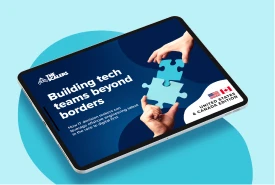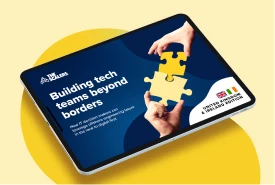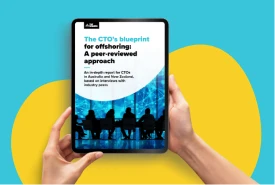Structure your offshore development team for long-term success by following these practices:
- Build the right foundation first. Hire senior developers before project managers, get your first 3 hires right (they set the culture), and create a functional team structure with clear roles.
- Embed engineers in your business and give them ownership. Involve them in product decisions from day one, coach them through trade-offs, and let them own outcomes, not just execute tasks.
- Keep teams engaged and connected. Support growth through training and R&D, visit your team in person, bring top performers to headquarters, and make work rewarding beyond the paycheck.
One of the biggest challenges you’ll face when building your offshore team is deciding on its structure. Especially if it’s your first time offshoring.
At The Scalers, we’ve built over 130 teams in the past decade and have helped companies that were exploring offshoring for the first time and others that had not-so-good experiences when setting up a team thousands of miles away from their headquarters. We’ve seen what works and what doesn’t.
In this article, we share 10 lessons on how to structure your offshore development team, so you can start working on your team composition with confidence and so your engineers can deliver value from day one.
Lesson 1: Spend time working closely with your developers before hiring a project manager or coordinator
Many companies think they need a project manager (PM) from day one to “manage everything offshore.” However, if no one on that offshore team understands your standards and expectations around delivery, the PM will never have the right impact.
Start with senior developers who can solve problems independently. Let them work directly with your in-house stakeholders – product leads, technical leaders and other specialised functions within your teams. This direct connection can lead engineers to understand the ‘why’ behind what they’re building, not just the ‘what.’ They ask better questions and catch issues early.
What you don’t want is a PM creating a bottleneck between your business needs and the people writing code. When everything gets filtered through someone who wasn’t in the original conversation, engineers become task-takers rather than problem solvers! Critical details never reach them.
Once your seniors are fully staffed, hire mid-level engineers to create backups and take on routine work. This frees your senior developers to focus on the most critical problems. This way, you’re building technical depth, rather than debt.
The PM conversation can happen later if coordination genuinely becomes a challenge. But get your foundation right first.
Lesson 2: Your first hires set the culture
Your first hires matter. A lot. These are the people who will (consciously or not) set the standard for quality and work culture on your offshore team from day one.
Many companies focus solely on technical skills, evaluating the engineer’s expertise in a specific technology and their years of experience in the field. Don’t get us wrong: those things matter, but they’re not enough if you want high performance. You also need people who communicate well, handle ambiguity without freezing up, and are open to feedback and thrive in a team.
What we’ve noticed when building dedicated development teams for our partners is that a natural leader organically emerges from those initial hires. It might not be the first person you bring on. Sometimes that first hire doesn’t work out during probation, but within that initial group, someone will step up.
That person becomes your culture carrier, your standard setter, the one who trains new joiners. They can help set the right tone and champion it for you, provided you put the effort to align them with your vision and standards in the first place.
Get your starters well integrated, and they’ll thrive, freeing up bandwidth while adding value to your business.
Lesson 3: Build a functional tech team – one that understands new tools, collaboration and efficient scaling
When you’re structuring your offshore team, it’s tempting to think you can hire a lead who’s a ‘10x coder’ or a ‘vibe coder’ and let them run the show. This isn’t necessarily a bad approach, but, as obvious as it may sound, it’s essential to stay realistic in your expectations.
It’s critical to hire dedicated developers and other specialists with the right skills, but before you can fill positions, you need to be certain that what you need is well-defined and achievable. If you don’t properly define what ‘good’ looks like in each role, it’s harder to set the team up for success.
Here’s an example of a functional early-stage offshore team composition, what they do, and how they collaborate:
- 1 Leader. They’re part of the initial hires we talked about in Lesson 1, with whom you maximised your time early on to ensure they can evangelise your product vision to the team. The leader of your offshore team is a veteran developer who is still hands-on and won’t shy away from coding. They’re writing code, reviewing pull requests, and setting the technical direction.
- 1-2 Seniors. They tackle complex, ambiguous problems that don’t have obvious solutions. They maintain code quality through reviews and refactoring, establish best practices, and train mid-level and junior developers.
- 1-2 Mids. They execute well-scoped tasks, prepare foundational work that seniors can build on, and handle the necessary ‘grunt work’ that keeps projects moving forward. Mids implement features based on clear specs, write tests, fix bugs, and gradually take on more ownership as they grow.
- 1 QA. They catch issues before customers do. QA engineers test new features, write automated test scripts, verify that code meets specifications, and document bugs clearly so developers can fix them fast.
With this structure, everyone on your team has clear responsibilities, yet there’s enough overlap for people to learn from each other. It also clarifies staffing and growth paths down the line, making the roles more attractive to candidates.
Before we move on to the next lesson, here’s one hiring insight we’ve seen play out: sometimes a newly promoted senior with about 6 years of experience outperforms a 12-year veteran. They’re hungrier to prove themselves and eager to grow. We all know that experience matters, but so does attitude.
Lesson 4: Embed new hires into your product and business context from day one
We covered the importance of direct stakeholder-developer connections in Lesson 1. Now let’s talk about what happens once those developers join your team.
Instead of just providing new hires with a wiki and expecting them to get up to speed, involve them in product conversations, sprint planning, and customer discussions immediately. Let them see how decisions get made and why certain trade-offs exist. This is how you can better imbibe them into your culture by understanding how you’re building, rather than simply reading about it. Some companies start by embedding their first offshore hires into existing scrum teams at home before creating independent pods offshore.
Documentation matters, but smaller companies often don’t have much of it. This is where your first senior offshore hires can help. As they learn your product and systems, have them document what they’re learning. This serves two purposes: it deepens their understanding and creates resources they can use to onboard future team members and delegate routine tasks.
Larger organisations with comprehensive documentation have an easier time onboarding since new hires have a clear reference point. But even excellent documentation can’t replace real-life stories from the people who built the product and lived through the decisions. For you, that’s your offshore first hires, who in turn become the guiding star for future offshore hires.
Lesson 5: Give engineers ownership
After embedding engineers into your product context, let them own outcomes.
The best way to build ownership is by coaching engineers through their early decisions. Walk them through how you think about problems and weigh trade-offs. When you make a call, explain why, not just what you decided, but the factors you considered. This teaches them your decision-making framework so they can make better calls on their own next time.
Show them how you balance competing priorities: technical debt against new features, speed against quality, short-term wins against long-term stability… When engineers understand these trade-offs, they stop waiting for direction and start thinking like owners.
Invest this time early, and ownership becomes natural.
We once worked with a partner who skipped this process entirely. They negotiated hard on price, brought on a new engineer, then immediately left for a three-month holiday. The engineer had no proper onboarding and no ownership of his work.
This partner wanted cheap labour without commitment. We tried to salvage it by sending the engineer on-site to learn the business firsthand, but it didn’t matter. The partnership fell apart. Cost mattered more to them than building a team that could own technical decisions.
Lesson 6: Keep talent engaged with growth opportunities
Daily tasks alone won’t sustain your offshore developers’ motivation in the long run. They require opportunities to develop their skills and implement new knowledge in their work.
We encourage companies to support cross-training:
- Involve engineers in architectural discussions.
- Rotate them across different components of the product so they understand the full system, not just their corner of it.
- Give them access to courses, certifications, or conferences that can help them grow professionally.
- Let them develop POCs to experiment with tools and frameworks they’re curious about
When engineers see opportunities for growth, they are motivated to do more. They learn and apply new skills at work and, at the same time, address company-specific challenges. That’s a win-win in our book!
Some offshore development partners go the extra mile by providing an internal Learning and Development Manager who runs both technical and soft-skills training tailored to the company’s needs in areas such as communication, problem-solving, emotional resilience, time management, and building trust within teams.
These trainings allow offshore engineers to eventually (within 12 to 24 months) become proactive in solving business challenges.
Learning and skill development initiatives are just a stepping stone to creating a true culture of growth. Just remember: technical expertise matters, but so do people skills – especially when offshoring – where clear communication makes or breaks collaboration.
Lesson 7: Allow time and tools for devs to do R&D
Some offshore engineers might have more expertise in certain technologies or domains than others on your team. Why not leverage their skills and give them the opportunity to develop, explore, and innovate other avenues?
R&D benefits everyone: engineers’ engagement increases because they’re solving interesting problems, and your business gets tailored solutions you might not have come across.
Take PEI Group, a London-based fintech intelligence company operating across seven countries. In 2023, they partnered with us to build an offshore team in Bangalore. Their initial goal was to revamp 16 brand websites and develop two new sites.
What started as one Scrum team has now expanded to five Scrum teams, plus a Data team and a CRM team (and more positions are being filled as of today!). These teams work directly with PEI’s VP of Engineering, Head of Data, and UK-based designers and analysts.
PEI gave the offshore team transparency, knowledge-sharing, and full ownership, and exposed them to diverse data types and processes, broadening their expertise.
As a result, the team developed two new brand websites delivered ahead of schedule, increased subscription growth, added two new brands to PEI’s portfolio, built a CRM team from scratch, and introduced AI-driven enhancements across its digital platforms.
That’s what happens when you give engineers the time, tools, and trust to do real R&D.
Lesson 8: Visit your offshore team as soon as possible
Book the flight. Go see your team in person.
Visiting your offshore team early does more than you’d expect, as it humanises everyone involved. Your engineers stop being names in Slack and become real people you’ve shared a meal with; you stop being an abstract boss and become someone who actually shows up.
This accelerates trust and bond-building in ways that video calls can never replicate. The cultural impact of sharing a meal and giving real time (outside office hours) during your visit is priceless. You can set the high-level vision face-to-face, align the team’s culture with yours, and address questions that people might not ask on video calls.
From a practical standpoint, it’s much cheaper for you to fly to your engineers, especially if they’re located far away. This benefits your business by making it more attractive to engineers, who prefer companies that invest in relationships rather than just output.
Lesson 9: Integrate your team into the core of your company
Once you’ve established a stable offshore team with a proven track record, it’s natural for top performers to start considering what’s next for them and evaluating their career path.
This often presents a good opportunity to invite them to your headquarters, either as guests at your annual event or for a specific project or work assignment. In either case, enabling them to meet key stakeholders builds bonds and loyalty that are difficult to quantify in monetary terms.
It strengthens their connection to the company and its mission, as they get a broader perspective of how everything works. You’re bringing them to the heart of your business, and they feel it!
Treating this experience as a reward matters. Engineers who get flown to your office feel valued because it signals that you’re invested in them long-term, which makes them want to stick around. They return motivated, loyal, and ready to pass that energy on to the rest of the team.
When they go back to the office, they share with the rest of your offshore engineers what they learned, the people they met, and why the work matters beyond their individual tasks. And that context gets passed down. New hires integrate faster because they’re joining a team that already feels invested in the company’s success.
Lesson 10: Keep things fun!
Your offshore team works hard. Make sure they’re having a good time, too.
Engineers might relocate for your role, sometimes without family or close friends nearby. They’re starting fresh in a new city, adjusting to a new company, and figuring out where they fit. If all they have is work, burnout and turnover follow quickly.
This is where your offshore partner steps up. It’s their responsibility to celebrate milestones, recognise achievements, and, in general, create a space for your team to connect as people, not just coworkers.
At The Scalers, every partner’s team has a Chief Happiness Officer (CHO) dedicated to their well-being. The CHO takes care of the full lifecycle of engineers and creates a place where people actually want to be. CHOs oversee daily operations, support work-life balance, and organise team outings and cultural events that build real connections.
Don’t underestimate the human side of offshoring. A team that enjoys working together works better together. Keep things fun, and everything else gets easier!
Build and structure your offshore development team the right way
In this article, we’ve walked you through the lessons we’ve learned from building over 130 offshore teams for our partners. We’ve covered everything from your first three hires and team composition to giving engineers ownership, supporting their growth, and building real connections through site visits and R&D opportunities.
But even after reading this, you might still have questions about how to structure your offshore development team. Sometimes it comes down to finding the right model to set up and scale effectively.
That was the case for My Muscle Chef, Australia’s leading premium fresh ready-made meal and functional food company. They tried different models and team structures, like outsourcing to the Philippines, but nothing clicked. Until they contacted our team at The Scalers.
Thanks to our unique offshore model, they finally found offshoring success. Our partnership started in 2023 and has already delivered tangible results: My Muscle Chef achieved a 50% boost in development capacity and a 70% reduction in tech debt, thanks largely to their offshore team.
To me, typical offshoring or outsourcing is usually about cost saving and not scaling. I wanted a properly distributed model where we have a true team where I have control over all my engineers and can scale when needed. We now have this in place and it is working very well.
If you’re ready to build an offshore team that actually works, get in touch. One of our senior executives will contact you and help you structure a team that scales with your business.
FAQs
Not at the beginning. You’re better off hiring senior developers who can solve problems and make decisions on their own. Let them talk directly to your product leads or CTOs so they understand the business context behind what they’re building. Once those seniors are busy with critical work, bring in mid-level engineers to handle routine tasks. A PM makes sense later, when you actually have coordination challenges worth managing.
Start with one technical leader who can manage people but still writes code, and add one or two senior developers to handle the hard problems and mentor others. Then, bring in one or two mid-level engineers to execute tasks and keep things moving. Include one QA engineer to catch bugs before they reach customers. This setup keeps work flowing without bottlenecks and gives everyone room to grow.
Usually, because companies prioritise just cutting costs over building relationships. They negotiate aggressively on price, then vanish after hiring, leaving new engineers without context, support, or clear direction. Engineers end up waiting for instructions instead of solving problems. Offshore teams need ownership and engagement to succeed, not just a contract.
We make sure engineers feel connected to their work and the partner they are working for. Every team gets a dedicated Chief Happiness Officer who handles daily well-being and organises events, and we provide soft skills training and encourage R&D so engineers keep learning. Plus, partners bring top performers to headquarters for face-to-face collaboration. This approach keeps our turnover under 15%, half the industry average, because people stay when they’re valued and growing.
Build Your Team,
Not Just a Contract
With The Scalers’ offshore dedicated development team, you get engineers who join your workflow for the long run. Grow steadily, stay flexible, and work with people who care about the product as much as you do.








